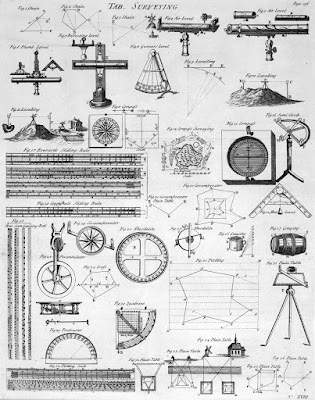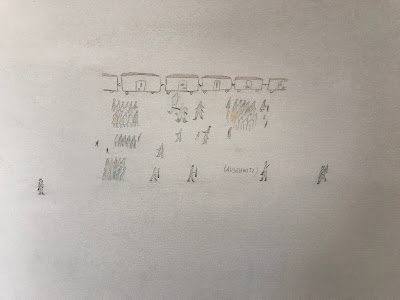We don't think of the ancient world as being one that was rich in technological innovation or progress. And yet in a number of areas, there were very significant developments in technology -- in ships, mining, fortification, siege engines, road-building, and bridges and aqueducts, for example. And there is the intriguing example of the Antikythera mechanism (
link), dating from the first century BCE and lacking a clear technological context, but establishing firmly the availability of advanced metal-working techniques and complex geared mechanisms. (Two fascinating videos are linked on the earlier blogpost on the Antikythera mechanism.)
John Peter Oleson's The Oxford Handbook of Engineering and Technology in the Classical World provides an extensive survey of the current state of knowledge about the topic, drawing upon the work of dozens of experts in classical scholarship. Here is the table of contents of the volume, from which the reader can get a very good idea of the topics and technologies considered:
Part I Sources
1. Ancient Written Sources for Engineering and Technology, Serafina Cuomo 2. Representations of Technical Processes, Roger Ulrich 3. Historiography and Theoretical Approaches, Kevin Greene
Part II Primary, Extractive Technologies
4. Mining and Metallurgy, Paul T. Craddock 5. Quarrying and Stoneworking, J. Clayton Fant 6. Sources of Energy and Exploitation of Power, Orjan Wikander 7. Greek and Roman Agriculture, Evi Margaritis and Martin K. Jones 8. Animal Husbandry, Hunting, Fishing, and Fish Production, Geoffrey Kron
Part III Engineering and Complex Machines
9. Greek Engineering and Construction, Fredrick A. Cooper 10. Roman Engineering and Construction, Lynne Lancaster 11. Hydraulic Engineering and Water Supply, Andrew I. Wilson 12. Tunnels and Canals, Klaus Grewe 13. Machines in Greek and Roman Technology, Andrew I. Wilson
Part IV Secondary Processes and Manufacturing
14. Food Processing and Preparation, Robert I. Curtis 15. Large-Scale Manufacturing, Standardization, and Trade, Andrew I. Wilson 16. Metalworking and Tools, Carol Mattusch 17. Woodworking, Roger B. Ulrich 18. Textile Production, John P. Wild 19. Tanning and Leather, Carol van Driel-Murray 20. Ceramic Production, Mark Jackson and Kevin Greene 21. Glass Production, E. Marianne Stern
Part V Technologies of Movement and Transport
22. Land Transport, Part 1: Roads and Bridges, Lorenzo Quilici 23. Land Transport, Part 2: Riding, Harnesses, and Vehicles, Georges Raepsaet 24. Sea Transport, Part 1: Ships and Navigation, Sean McGrail 25. Sea Transport, Part 2: Harbors, David J. Blackman
Part VI Technologies of Death
26. Greek Warfare and Fortification, Philip de Souza 27. Roman Warfare and Fortification, Gwyn Davies
Part VII Technologies of the Mind
28. Information Technologies: Writing, Book Production, and the Role of Literacy, Willy Clarysse and Katelijn Vandorpe 29. Timekeeping, Robert Hannah 30. Technologies of Calculation, Part 1: Weights and Measures (Charlotte Wikander), Part 2: Coinage (Andrew Meadows), Part 3: Practical Mathematics (Karin Tybjerg) 31. Gadgets and Scientific Instruments, Orjan Wikander 32. Inventors, Invention, and Attitudes toward Innovation, Kevin Greene
Part VIII Ancient Technologies in the Modern World
33. Expanding Ethnoarchaeology: Historical Evidence and Model-Building in the Study of Technological Change, Michael B. Schiffer
Many of the technologies described here are important and interesting, but familiar: ships, mines, fortifications, and other common interactions with the natural world. The most surprising technology innovations are described in Part VII, "Technologies of the Mind", and here there is more information about "high technology" in the ancient world. Orjan Wikander describes "gadgets and instruments" in chapter 31, which is a topic that sheds more light on advanced technical and scientific innovation -- and therefore provides some intellectual background for the design and fabrication of the
Antikythera mechanism. What is most eye-opening about the details of the
Antikythera mechanism is the intricate design of the gearing system that it embodied and the advanced metal-working techniques that it presupposed for fabrication (cutting precision gear wheels and most puzzling, cutting concentric tubes to convey motion from one gear assembly to an output ring). Wikander makes it clear that the principle of geared machines was familiar in the Hellenistic world (for advanced mathematicians and philosophers, at least). Field and Wright report on a Byzantine sundial calendar geared device dating from about 500 AD, whose gears are very similar to those used in the
Antikythera device;
link. They take this as evidence of an ongoing engineering tradition in the Greek world of fabrication of geared devices. (Notably, the sundial calendar is substantially less complex than the
Antikythera mechanism, implying a loss of technological knowledge over the intervening 500 years.)
But there is an interesting complication about these high-tech astronomical devices for the history of technology: these devices were advanced and sophisticated, but they appear to have had little practical utility. It appears to be widely agreed, for example, that the Antikythera device had no use as a navigational instrument; instead, it appears to be an entertaining demonstration of astronomical knowledge for an elite audience. A more useful geared instrument, apparently, was the "hodometer", a wheeled and geared device that could be pulled along a route and used to measure distance. But this is an important guidepost in the study of the history of technology: the innovation and development of the "gadget" itself does not ensure its proliferation and widespread adoption. It needs to find a need within ambient society to which the gadget can be adapted in a useful way.
An interesting challenge of measurement in the ancient world was time. Robert Hannah's chapter on "Timekeeping" provides a very interesting account of shifts in both the conception of time and the means that were available or developed to measure its passage. It is evident that it is not possible to engage in the science of mechanics without a way of measuring equal intervals of time -- key variables like velocity, acceleration, inertia all require an account of distance covered per unit of time. Most fundamentally, it isn't possible to form the concept of velocity unless one has a fairly definite conception of units of time. "Fast" and "slow" are imaginable; but 4 m/s is not.
A little bit of reflection will show that there are at least two different problems encompassed under "timekeeping". First, we may have reasons for wanting to know "what is the time of day at the moment?", by which we mean, most fundamentally, how long past sunrise (or before sunset) is it currently? And how long until dinner? In this context it is very interesting (and eyebrow-raising) to learn of "unequal hours" involved in Greek timekeeping:
Sundials helped inculcate into society the concept of the seasonal, or unequal, hour. For most purposes in antiquity, such hours were the norm. From Egypt came the notion that each day or night could be divided into 12 hours from sunrise to sunset, and another 12 from sunset to sunrise (Parker 1974: 53; Quirke 2001: 42). Since daytime and nighttime change in length with the seasons, the length of each hour therefore changed also according to the season. Only at the spring and autumn equinoxes were the hours equal through the whole day. (p. 749)
So a person's pulse (beats per sixtieth of an hour) will be different, depending on whether it is measured in daytime or nighttime. Suppose the individual's real pulse rate at equinox is 70 beats per sixtieth of an hour and it never changes. When measured on December 22 by counting beats for an hour and dividing by 60, his/her pulse will be 54 bpm; the same measurement on June 22 results in a pulse of 86 bpm. Further, length of day is influenced by latitude as well as season; so the same individual would have a different pulse rate in Miami than in Helsinki, on the same day. Measuring pulse by such a system is useless as a tool for assessing health status. And how about cooking -- what is the result of a variable hour for a 4-minute soft-boiled egg?
The harder challenge of time measurement is the problem of measuring "duration of time" -- how many minutes it takes to walk from the agora to the Acropolis in Athens, how long it takes the arrow to fly from the archer to the target, how long the egg has been boiling. The problem of time-telling can be handled reasonably well by use of a sundial (during daylight hours) and by the position and elevation of the stars by night, but a sundial is not a practical instrument for measuring duration.
What is needed for measuring duration is an absolute measure of "equal interval of time" that can be used to measure duration -- ticks of a clock, swings of a pendulum of a certain length, vibration of a cesium atom, movement of a violin string tuned to E, movement of the fork of a tuning fork tuned to A. More exactly, what is needed is a process that occurs in the same period of time every time it is invoked; and a way of counting the number of times the event has occurred during the process to be measured. Each of the processes mentioned here identifies a discrete event that always takes the same amount of time from beginning to end. The difficult challenge is an automatic way of counting events. Mechanical clocks "count" events by advancing a geared mechanism, moving pointers on a dial.
The water clock (clepsydra) and sand clock both served to measure duration through the idea that the flow of a liquid or viscous substance through a constrained opening takes a regular amount of time. So a bucket with a hole in the bottom was used to measure the period in which legal arguments needed to be made in Athenian proceedings (752).
Here is a novel clock mechanism that could have been used. Suppose we construct a 6.21013-meter pendulum. It has a period of 5.0 seconds. This solves the first part of the problem: an event that always takes the same amount of time. But how to count events in order to measure extended periods of time? Suppose we design a simple device in which a small bucket with volume of 10 cm^3 is fitted to a lever and is triggered by a tap of the pendulum. It empties into a calibrated glass vessel and is refilled automatically in the next several seconds. After the first cycle the calibrated vessel contains 10 cm^3; after 50 cycles the vessel contains 500 cm^3 of water and 250 seconds have elapsed. After 17,280 cycles the calibrated vessel contains 172,800 cm^3 of water (172.8 liters), and 24 hours have elapsed. The calibration of the vessel permits the user to measure the amount of time (number of swings of the pendulum) that have occurred since beginning the process, by measuring the volume of the water. A large vessel (200 liters) will permit measurement of periods extending over a full 24 hour period; a narrow vessel can be calibrated to permit precise measurement of short intervals (5 minutes). The clock will be precise to the range of 5 seconds -- perfectly sufficient for boiling 4-minute eggs. And the precision of the timepiece can be increased by shortening the pendulum; a .5 meter pendulum has a period of 1.42 seconds.
(In this example the clock was initiated at midnight, and the level of the water indicates that the time is now 10:00 am.)
(Who can direct me to the Agora patent office? All royalties will be directed to the defense fund established on behalf of Professor Socrates.)
Once we have a system for measuring intervals of time, it is possible to define and measure other important physical quantities: velocity, acceleration, the period of a pendulum, the frequency of a vibrating string, a mammal's pulse. So measurement of mid-range intervals of time is crucial to the development of physics and mechanics as well as other areas of science -- as is evident from the Renaissance scientists such as Galileo. Conversely, without such a system of time-interval measurement, many important physical laws cannot be discovered. Ancient Greek and Roman scientists had reasonably effective instruments for measuring distance, and only very limited instruments for measure elapsed time. Time on the scale of a month or a year could be measured by observation of the movements of the moon and the planets; but time on the scale of seconds and minutes could not be measured by these means.
(Wikander is best known for his research on water technologies, including especially water mills. Here is an interesting page outlining changing knowledge over the past several decades on the extent of use of water mills during the classical period (
link).)







